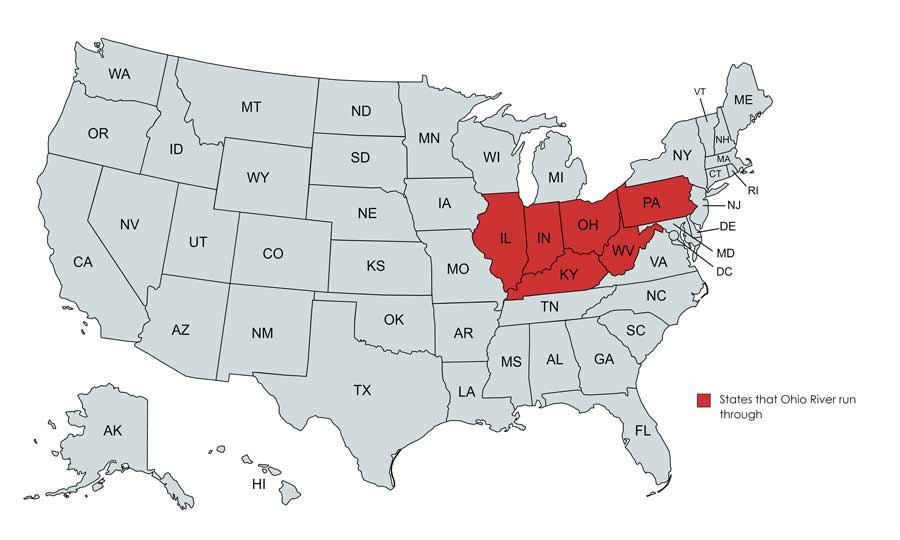What States Does The Ohio River Run Through?

The Ohio River runs through six states: Illinois, Indiana, Kentucky, Ohio, Pennsylvania, and West Virginia.
But there is so much more to learn about the Ohio River, one of the most famous things about Ohio.
Did you know that the state of Ohio doesn’t actually own the Ohio River? Or that the Ohio River is the main drinking water source for more than five million people? While it’s by no means the longest or largest in the U.S., the Ohio is a major river artery of the east-central United States.
In this article we’ll explore not only the answer to the question, what states does the Ohio River run through?, but will also take a look at some fascinating geographical aspects and facts that make this river special.
Contents
- What States Does the Ohio River Run Through?
- Where Does the Ohio River Start and End?
- Which State Has the Legal Ownership of the Ohio River?
- Quick Facts About the Ohio River
- FAQs About the Ohio River
- How Many States Does The Ohio River’s Drainage Basin Include In Part?
- What Cities Does The Ohio River Run Through Or Border?
- What Are Some Of The Major Tributaries Of The Ohio River?
- How Old Is The Ohio River Based On A Geographical Standpoint?
- How Long Is The Ohio River Compared To Other Rivers In The United States?
- Who Was The First To Travel The Waters Of The Ohio River?
Advertising Disclosure: What States is a for profit reference website, supported by advertisements. Thank you for supporting our mission to make geography fun for all!
What States Does the Ohio River Run Through?
The Ohio River runs through or along the border of six states:
- Illinois
- Indiana
- Kentucky
- Ohio
- Pennsylvania
- West Virginia
The river starts where the Allegheny and Monongahela Rivers meet, and that point is in Pittsburgh, Pennsylvania.

Where Does the Ohio River Start and End?
The Ohio River begins in Pittsburgh, Pennsylvania, and stretches for 981 miles until it ends at Cairo, Illinois. This is where the Ohio River drains into the Mississippi.
One of the most interesting things to know about the Ohio River is that it’s the largest tributary of the Mississippi River in the United States. Of course, this ranking is based on volume.
Which State Has the Legal Ownership of the Ohio River?
Out of the six states that the river runs through, Kentucky has ownership of the Ohio River.
It goes without saying that the other states have claimed ownership of different stretches of the river since the late 1700s.
Of course, that was all because the Ohio River was a major trade route. Yet, in 1792, the government decided that it was Kentucky that owned the Ohio River along the state’s border with Ohio, Illinois, and Indiana.
The reason behind this decision is that this boundary was the low point of the river’s northernmost bank.
About two centuries later, the State of Ohio sought to gain the claim to the Ohio River a second time. In 1966, the state made a point that the course of the river had fluctuated since 1792, making the aforementioned low point near the south bank of the river today.
However, the United States Supreme Court didn’t change the legal ownership of the Ohio River, so it still belongs to Kentucky until this day.
❓ Trivia Time: Do you know which states the other major US rivers flow through?
- Which states does the Mississippi River flow through?
- Which states does the Colorado River flow through?
- Which states does the Mississippi River flow through?
Quick Facts About the Ohio River

- The Ohio River is around 24-25 feet deep on average [Source]
- The widest point along the Ohio River is around 1 mile near Smithland, Kentucky
- 160 species of fish live in the Ohio River and its smaller branches
- Roughly 8% of the U.S. population resides in the Ohio River Basin
- The first lock and dam to be built on the Ohio River was constructed in 1885
- The Ohio River was naturally shallow, its original depth from 3 to 20 feet
- The Ohio River is home to 38 power generating facilities
- Each year, the river transports more than 184 million tons of cargo
- The Ohio River faces a critical pollution issue caused by abandoned mines, agricultural impact, and urban runoff
- The Ohio River contributes more water to the Mississippi than any other tributary does
- The river drains an area of about 203,900 square miles
FAQs About the Ohio River
How Many States Does The Ohio River’s Drainage Basin Include In Part?
The drainage basin of the Ohio River features parts of 15 states. These states are:
Pennsylvania
New York
Ohio
Maryland
West Virginia
Kentucky
Tennessee
Illinois
Georgia
Alabama
North Carolina
Mississippi
South Carolina
Virginia
Indiana.
What Cities Does The Ohio River Run Through Or Border?
The Ohio River flows through countless cities, but the major ones include:
Pittsburgh
Cairo
Louisville
Ashland
Covington
Wheeling
Portsmouth
Cincinnati
Madison
Evansville
Mount Verno
What Are Some Of The Major Tributaries Of The Ohio River?
From the north, the Ohio’s tributaries are the Miami, Scioto, Wabash, and Muskingum rivers.
On the other hand, you have the Licking, Big Sandy, Tennessee, Kanawha, Kentucky, Cumberland, and Green rivers from the south.
How Old Is The Ohio River Based On A Geographical Standpoint?
Quite surprisingly, the Ohio River is pretty young geographically.
Technically, the river’s formation started between 2.5 and 3 million years ago, and that point marks the occurrence of the earliest ice ages. This is also when several portions of the north-flowing rivers were dammed thanks to the formation of ice, resulting in smaller rivers.
How Long Is The Ohio River Compared To Other Rivers In The United States?
As we all know, the Missouri River is the longest in the U.S., followed by the Mississippi. However, the Ohio River doesn’t make it to the top three or even five longest rivers in the State.
To make the picture clearer, the Ohio River is the tenth longest river in the United States, which is still pretty much a big deal after all!
Who Was The First To Travel The Waters Of The Ohio River?
The first European person to ever travel the Ohio River was the French explorer René-Robert Cavelier, Sieur de La Salle. It’s said that he descended the river until he met a waterfall, which historians believe is the Falls at Louisville.
Because the Ohio was a strategic waterway for trading and transportation, it was a key factor in the struggle between the French and the English in the 1750s.
❓ Trivia Time: What States Does The Missouri River Run Through?






